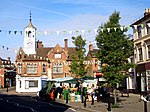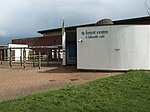Houghton House
AmpthillCountry houses in BedfordshireEnglish Heritage sites in BedfordshireGrade I listed buildings in BedfordshireGrade I listed houses ... and 5 more
Grade I listed ruinsRuined housesRuins in BedfordshireTourist attractions in BedfordshireUse British English from February 2023

Houghton House is a ruined mansion house in the parish of Houghton Conquest, Bedfordshire. It is a Grade I listed building, positioned above the surrounding countryside, and commands excellent views. Built from 1615 to 1621, it is said that the house was the model for House Beautiful in John Bunyan's The Pilgrim's Progress (1678). It was abandoned in 1794 and stripped (by the owner) of its interiors and roof for sale as building supplies. Today the property is owned by English Heritage, and is open to free public access during daylight hours.
Excerpt from the Wikipedia article Houghton House (License: CC BY-SA 3.0, Authors, Images).Houghton House
Gas House Lane,
Geographical coordinates (GPS) Address External links Nearby Places Show on map
Geographical coordinates (GPS)
| Latitude | Longitude |
|---|---|
| N 52.044 ° | E -0.48626 ° |
Address
Houghton House
Gas House Lane
MK45 2EY
England, United Kingdom
Open on Google Maps







